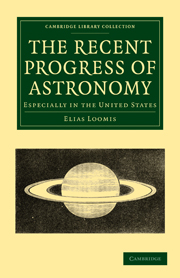Book contents
- Frontmatter
- PREFACE
- Contents
- CHAPTER I RECENT ADDITIONS TO OUR KNOWLEDGE OF THE PLANETARY SYSTEM
- CHAPTER II RECENT ADDITIONS TO OUR KNOWLEDGE OF COMETS
- SECTION I
- SECTION II
- SECTION III
- SECTION IV
- SECTION V
- SECTION VI
- SECTION VII
- CHAPTER III ADDITIONS TO OUR KNOWLEDGE OF FIXED STARS AND NEBULÆ
- CHAPTER IV PROGRESS OF ASTRONOMY IN THE UNITED STATES
- POSTSCRIPT
- Frontmatter
- PREFACE
- Contents
- CHAPTER I RECENT ADDITIONS TO OUR KNOWLEDGE OF THE PLANETARY SYSTEM
- CHAPTER II RECENT ADDITIONS TO OUR KNOWLEDGE OF COMETS
- SECTION I
- SECTION II
- SECTION III
- SECTION IV
- SECTION V
- SECTION VI
- SECTION VII
- CHAPTER III ADDITIONS TO OUR KNOWLEDGE OF FIXED STARS AND NEBULÆ
- CHAPTER IV PROGRESS OF ASTRONOMY IN THE UNITED STATES
- POSTSCRIPT
Summary
On the 22d of August, 1844, Father De Vico, director of the observatory at Rome, discovered a telescopic comet in the constellation of the Whale. He immediately announced the discovery to Professor Schumacher, of Altona, but his letter did not arrive till the 26th of September. Meanwhile, the comet had been discovered independently by several different observers. It was seen by Professor Encke at Berlin on the 5th of September, and on the 6th it was seen at Hamburg by M. Melhop, an amateur astronomer. On the 10th of September it was discovered by Mr. H. L. Smith of Cleveland, Ohio, who observed it every day for nearly a fortnight. About the third week in September, it was just discernible with the naked eye, and with slight optical aid had a very beautiful appearance, the nucleus being bright and star-like, and having a tail about one degree in length, extending in a direction opposite to the sun. At the Pulkova observatory, the comet was followed till the 31st of December.
It was soon found by M. Faye and others, that the comet deviated remarkably from a parabolic orbit; and it was ascertained that the curve described was an ellipse with a periodic time of about five and a half years. Dr. Brünnow (formerly of Berlin, but now director of the observatory at Ann Arbor, Mich.), undertook a thorough investigation of all the observations, embracing a period of more than four months, and took account of all the planets within the orbit of Uranus. He thus obtained an orbit which satisfied all the observations with extreme precision, and indicated that the length of the comet's revolution was 1996.5 days, or 5.4659 years.
- Type
- Chapter
- Information
- The Recent Progress of AstronomyEspecially in the United States, pp. 136 - 139Publisher: Cambridge University PressPrint publication year: 2010First published in: 1856

